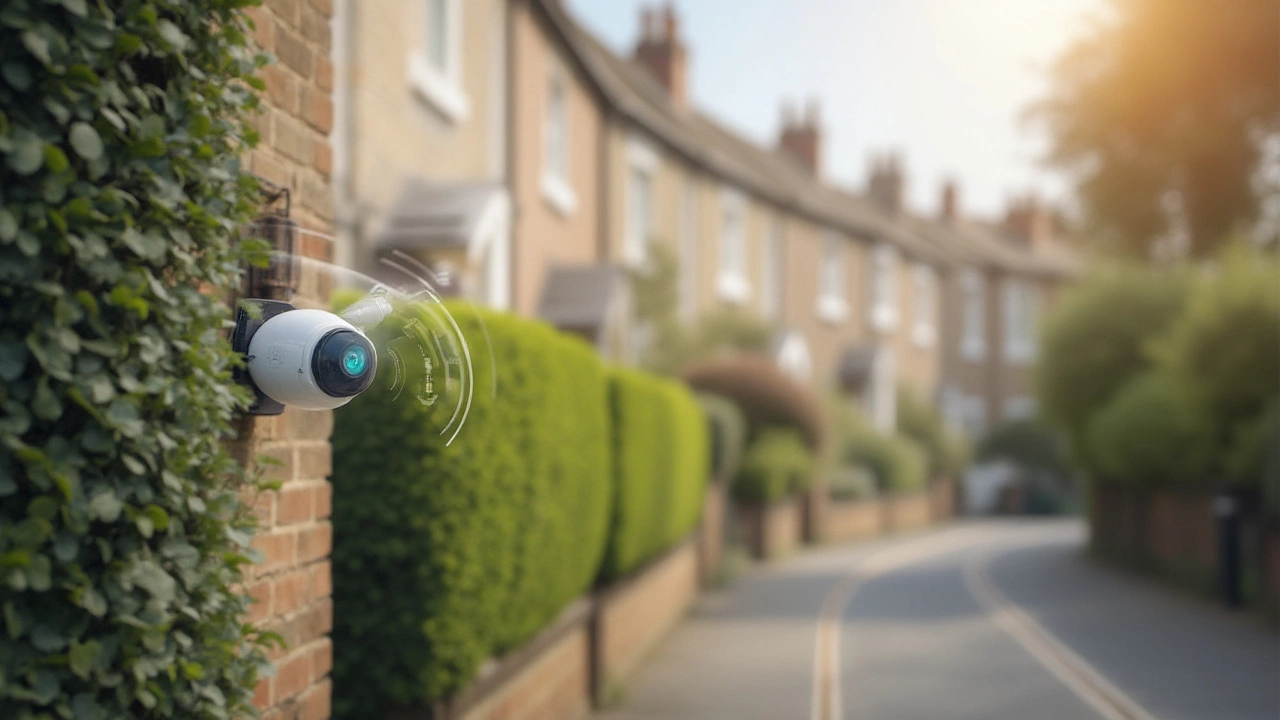If you’ve ever tried to angle a wireless security camera just right to watch your garage, you know the sinking feeling: bars on its signal meter plummet, the image freezes, then—nothing. It seems like these cameras promise freedom from cords, but there’s always a catch with how far they can really reach. A fancy box might promise "300 meters!" But does a camera ever deliver that in a real backyard? If you ever wondered what affects that range, or how to squeeze out a few more feet when you’re desperate, you’re in the right place.
What Really Sets the Limit: Wireless Security Camera Range Explained
Manufacturers love to toss out huge numbers on a camera box: “up to 500 feet!” Sounds great—until you try to mount one and find your signal dropping halfway to the shed. The truth is, a wireless security camera’s range is the maximum distance a camera can transmit signals to its base (or a Wi-Fi router) while staying connected and sending usable video. But you won’t get close to these maximums unless you live in an open field. You know what really eats up that distance? Walls, trees, windows, even baby monitors. Each one cuts a chunk out of the range.
For most modern wireless cameras, here are the general numbers you can actually expect:
- Typical Wi-Fi security cameras (2.4GHz): 150-250 feet indoors, 500 feet outdoors in an open line of sight.
- 5GHz Wi-Fi cameras: 50-150 feet indoors, up to 200 feet outdoors—better speed, but less range.
- Batteries vs. plug-in: The power source doesn’t change the wireless distance, but low battery can weaken the signal strength.
- Super-long-range systems: Some pro units with special antennas let you push signals up to half a mile, but you won’t see this in typical home cameras.
| Camera Type | Reported Max Distance (Outdoor, Line of Sight) | Likely Real-World Indoor Distance | Frequency Band |
|---|---|---|---|
| Standard Wi-Fi (2.4 GHz) | Up to 500 feet | 150-250 feet | 2.4 GHz |
| High-Speed Wi-Fi (5 GHz) | Up to 200 feet | 50-150 feet | 5 GHz |
| Specialized Antenna/Pro | Up to 2,500 feet | 1,000-1,500 feet | Usually 2.4 GHz |
| Bluetooth-enabled | 10-30 feet | Same | 2.4 GHz Bluetooth |
So, what trips up your camera’s wireless range inside a real house? Drywall eats up some signal, but it’s way worse when you toss in brick, stone, or thick stucco. Appliances like fridges and microwaves spill radio interference in every direction. Even your wireless headphones or your kid’s game controller can mess with things if you’re unlucky. Every time the signal has to bounce, bend, or fight another wave, it drops strength. It’s kind of like shouting down a hallway—if there’s a wall in the way, nobody hears you.
Got trees or metal fences in the yard? Signal can bounce off or get absorbed, dropping range outside too. One fun fact: double-paned windows with metalized coatings (the fancy “energy efficient” kind) act almost like a mirror for Wi-Fi, slashing the range if you try to aim the signal through a window.
What’s the Best Positioning for Maximum Security Camera Range?
If you want your wireless security camera to really stretch its legs, you can’t just slap it anywhere. Placement is everything. Put your camera as close to your router or base as possible while still getting the view you want. Each wall, floor, or big object eats away a bit more range, so fewer obstacles always win.
There’s also the “line of sight” idea: if you can see the router from the camera’s position (even if it’s far away), you’ll haul in the best possible signal. That’s what manufacturers mean when they drop those crazy 500-foot numbers. Houses are rarely built to make that easy, but even one fewer wall helps. If you’re going for a camera in the garage or the backyard, try to keep the wireless “path” as clear as you can—think of a straight tunnel of air from camera to base/station.
- Mount higher up (on a wall/eaves): Avoids furniture or cars blocking signals on the ground.
- Aim for corners: Sometimes signals travel further if there’s a path diagonally through a room.
- Keep the camera and the receiving device on the same floor, or, if needed, directly above/below each other for best signal between stories.
- Angle cameras away from thick metal or brick surfaces if possible.
- If you’re setting up more than one camera, don’t line them up to compete for the same Wi-Fi path. Spread out the load.
Ever wonder why your neighbor has an outdoor camera pointed right at the trash cans at the far back corner of their yard? Odds are, after lots of trial-and-error, that’s just the only corner that didn’t cut their signal to shreds.
Wi-Fi mesh networks have gotten super popular in the last few years, and they can work magic here. If your router’s Wi-Fi can’t quite reach where you want your camera, drop a mesh "node" somewhere halfway. Your camera will grab a strong signal from the mesh node instead of shouting all the way back to your main router. Even Wi-Fi extenders (sometimes called repeaters) can help, but mesh is usually smarter and less laggy.
If you live in a big house or one with weird dead zones, sometimes nothing helps except moving your main router. Pop it somewhere central—sometimes just one room over makes a world of difference. Trust me, I’ve asked my kids to test ‘kid cam’ around the house, and found some sweet spots by accident while they tried to prank me.

Busting the Myths: Wi-Fi, Antennas, & Camera Types
Let’s break some of the biggest wireless camera myths. First, it’s not just cameras that run on Wi-Fi. Some systems talk directly to a base, skipping the house Wi-Fi altogether. These are called "point-to-point" or "dedicated wireless." They can usually go further and don’t care if your home network is busy streaming movies while you’re checking the driveway feed. If you need a camera hundreds of feet from your house, pro-grade point-to-point may be your best bet. Some models let you mount an external directional antenna—even as DIY as old-school “Pringles can” antennas—dramatically boosting outdoor range. But the average home user usually sticks with built-in antennas.
Let me lay out a quick comparison so you can see what does what:
| System Type | Range Potential | Best Use | Notes |
|---|---|---|---|
| Standard Wi-Fi Cam (2.4 or 5 GHz) | Up to 250 ft indoors, 500 ft outdoors | General home monitoring | Needs home Wi-Fi; signal varies a lot by obstacles |
| Point-to-point wireless (pro or custom) | 1000+ ft outdoors | Large lots, barns, remote gates | Special antennas, usually pro install |
| Bluetooth camera | 10-30 ft | Baby monitors, simple entry use | Not used for serious security |
| Cellular (LTE-enabled) | As far as cell tower reach | Remote land, no Wi-Fi needed | Requires a SIM card/data plan |
Another hot tip: Higher frequencies (like 5GHz) carry more data, giving you sharper and faster video—which is why people love them for streaming. But these signals fade a lot faster with each wall or tree. If you’re stretching range to its max, stick to 2.4GHz cams—they’re slower but reach further and punch through obstacles better.
Watch out for the sound of "battery powered" being sold as "portable anywhere". Sure, a battery-powered camera can go up on a tree, way out on the fence, anywhere your imagination runs. But if it can't connect with your Wi-Fi or base, it’s just a fancy paperweight that will miss the shot when it matters. Always plan the placement for signal first, power second. And keep in mind, low battery sometimes throttles back the Wi-Fi for power saving, cutting your range even more until you recharge or swap batteries.
Getting the Most From Your Wireless Security Camera
If you’ve already tried stretching a camera across your property and had it “ghosted,” you’re not the first. But there are a handful of surprisingly simple tricks anyone can try to milk out every foot of your wireless camera’s range. Some you can do with stuff already lying around the house.
- Switch to the 2.4GHz band on your router if possible. Even if you love your speedy 5GHz for Netflix, cameras do better with range over bandwidth.
- Upgrade your router antennas if removable; higher-gain antennas can help with pushing Wi-Fi further, even through a few walls.
- Put your router/base high up and clear of clutter. Sticking it behind books, televisions, or fish tanks is a classic mistake.
- Try repositioning the camera, even by a few inches. Sometimes, just moving off a metal surface stops a signal-destroying echo.
- If you have multiple cameras, try splitting them across different Wi-Fi channels to avoid interference.
- Reduce traffic noise—pause any huge downloads or streaming while testing the camera’s feed for max range.
- Test each camera before permanent mounting. Take your phone (on Wi-Fi), stand where you want the camera, and run a signal strength test with a free app, or just see if your videos load fast. If your phone drops out, so will your camera.
- When desperate: Wi-Fi repeaters or mesh units can close dead spots with almost no effort—worth it for big yards or multi-story homes.
- Be cautious with solar-powered wireless cams: Panels need light, but if you mount them in the sunniest, but farthest spot, you can easily lose Wi-Fi contact.
Real world: I once had to explain to my kids why their “secret clubhouse cam” out back kept dropping off the app. Turns out, their chosen spot was right behind the neighbor’s metal shed—total Wi-Fi killer! The fix? We shifted the camera just three feet to the left, got away from the metal, and suddenly we were streaming crisp video without a hiccup.
While it’s tempting to trust box claims and marketing hype, nothing beats testing in your actual environment. House layouts, building materials, and Wi-Fi crowding all matter more than brand labels. If you want peace of mind for the long haul, don’t guess. Map your range with your camera (or even your smartphone), tweak your placement, and keep a few signal-boosting hacks up your sleeve. Then, you’ll know exactly how far your wireless security camera range can take you—no nasty surprises, no missed footage.

